Eco-paradigm Construction – One Community Weekly Progress Update #576
One Community is forwarding eco-paradigm construction, a holistic approach to sustainability covering food, energy, housing, education, economics, and social architecture. Our all-volunteer team is committed to creating a model that becomes self-replicating, fostering global collaboration through teacher/demonstration hubs. Grounded in the principle of “The Highest Good of All,” we open source and free-share our complete process, promoting fulfilled living and global stewardship practices. Join us in evolving sustainability, regenerating our planet, and creating a world that works for everyone.
- Here’s our project overview
- Here’s our world-change methodology
- Here’s how this becomes self-replicating
- Here’s how we are open source and free-sharing all the do-it-yourself designs
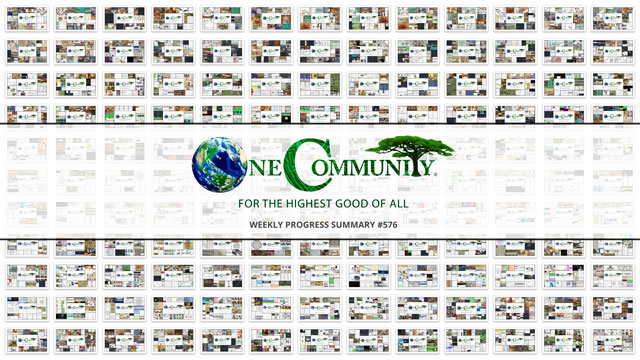
OUR MAIN OPEN SOURCE HUBS
Click on each icon to be taken to the corresponding Highest Good hub page.
One Community’s physical location will forward this eco-paradigm construction movement as the first of many self-replicating teacher/demonstration communities, villages, and cities to be built around the world. This is the April 1st, 2024 edition (#576) of our weekly progress update detailing our team’s development and accomplishments:
Eco-paradigm Construction
One Community Progress Update #576
DONATE | COLLABORATE | HELP WITH LARGE-SCALE FUNDING
CLICK HERE IF YOU’D LIKE TO RECEIVE AN EMAIL EACH WEEK WHEN WE RELEASE A NEW UPDATE
YOU CAN ALSO JOIN US THROUGH SOCIAL MEDIA
ONE COMMUNITY WEEKLY UPDATE DETAILS
HIGHEST GOOD HOUSING PROGRESS
 One Community is forwarding eco-paradigm construction through Highest Good housing that is artistic and beautiful, more affordable, more space efficient, lasts longer, DIY buildable, and constructed with healthy and sustainable materials:
One Community is forwarding eco-paradigm construction through Highest Good housing that is artistic and beautiful, more affordable, more space efficient, lasts longer, DIY buildable, and constructed with healthy and sustainable materials:
-
-
- Eco-paradigm construction: Our Upcoming Crowdfunding Campaign
- Learn about the different eco-paradigm construction village models: 7 Sustainable Village Models
- Visit the open source portals for the first two: Earthbag Village OS Hub | Straw Bale Village OS Hub
-
This week, Mithil Upadhyay (Mechanical Engineer) continued working on problem solving the designs for the Vermiculture Toilet. He focused on designing the 55 gallon drum using general dimensions found on the Internet. Mithil also designed the frame for the closing mechanism, aligning it with the discussions from the meeting and the presentation done in week 1, utilizing Solidworks for CAD design. Sustainable human waste processing options, like the vermiculture toilets, are a foundation of One Community’s open source eco-paradigm construction model. Below are some demonstration images of his work.
Vidhi Bansal (3D Visualization Artist) completed another week working on the Earthbag Village 4-dome home renders. She focused on refining techniques for working with translucent glass, enhancing foliage to fill up spaces, and adding a hot tub. She then updated the plinths and lighting to improve the overall environment, while addressing errors in the landscape. Vidhi also updated the clothing designs, ensuring accuracy in scales for both people and objects within the projects. Adapting our models to demonstrate traditional housing options is a part of One Community’s open source eco-paradigm construction model too. See the pictures below for examples related to this work.
DUPLICABLE CITY CENTER PROGRESS
 One Community is forwarding eco-paradigm construction through a Duplicable and Sustainable City Center that is LEED Platinum certified/Sustainable, can feed 200 people at a time, provide laundry for over 300 people, is beautiful, spacious, and saves resources, money, and space:
One Community is forwarding eco-paradigm construction through a Duplicable and Sustainable City Center that is LEED Platinum certified/Sustainable, can feed 200 people at a time, provide laundry for over 300 people, is beautiful, spacious, and saves resources, money, and space:
-
-
- Learn about this building and its function as part of eco-paradigm construction: Duplicable City Center Open Source Hub
-
This week, Nika Gavran (Industrial Designer) continued her work on the Duplicable City Center dormer window installation plans. She made an in-depth research and documentation on the process of creating dormer windows. She extensively researched architecture and construction sources to gain understanding of the assembly and placement of elements within a dormer window. Nika documented the tools utilized and the sequence of operations involved. She also reviewed the CAD files associated with the window to identify the constituent pieces within the assembly. The Duplicable City Center is a foundational part of One Community’s open source eco-paradigm construction model. See below for some of the pictures related to this work.
HIGHEST GOOD FOOD PROGRESS
 One Community is forwarding eco-paradigm construction through Highest Good food that is more diverse, more nutritious, locally grown and sustainable, and part of our open source botanical garden model to support and share bio-diversity:
One Community is forwarding eco-paradigm construction through Highest Good food that is more diverse, more nutritious, locally grown and sustainable, and part of our open source botanical garden model to support and share bio-diversity:
-
-
- Learn about the structures: Hoop House Hub | Aquapini & Walipini Open Source Hub
- See what we’ll be growing: Gardens & Hoop Houses | Large-scale Structures | Food Forest | TA
-
This week, the core team continued to focus on updating and expanding the Highest Good Food tools, equipment, and materials details. They researched, added new entries, and wrote detailed narratives to accompany each addition. They also researched about the specifications and features of Turftime heavy duty hydraulic dump trailers and the latest Woodland Mills TF810 Pro PTO Wood Chipper Walk Around. Highest Good food is an important part of creating the global eco-renaissance with One Community’s open source eco-paradigm construction plans. See their work in the collage below.
Charles Gooley (Web Designer) continued to work on the Vegan Rice Recipes page. This week, he focused on constructing several recipes including Sweet Potato Breakfast Bowl with Baked Beans, Chicken, Sweet Potato & Coconut Curry, Mexican Tomato Rice with Beans, Chia Seed Pudding, Alfredo Pasta with Chicken, Potato and Beans Casserole, and Brown Rice Pudding. Additionally, Mediterranean Baked Sweet Potatoes, Brown Rice and Spanish Chicken Stew, Vegan Cinnamon Rolls with Tofu Scramble, and Sautéed Potatoes and Creamy Herb Chicken were added. Also included were Spaghetti and Tofu, Quinoa Breakfast Pudding, Tomato Brown Rice Pilaf with Baked Tilapia, and Mashed Sweet Potatoes with Chicken Garlic Herb Sauce. Placeholder images were utilized, awaiting replacement with final images upon availability. Highest Good Food is an important part of eco-paradigm construction with One Community’s open source plans. See his work in the collage below.
Hayley Rosario (Sustainability Research Assistant) continued helping finalize the Highest Good Food rollout plan. This week, Hayley reviewed relevant documents, incorporated links, fixed formatting and addressed minor issues, as well as updated her portfolio at her request of a core team member. She inserted links in Highest Good Food within the “relevant pages” section, performed comparative analysis of the formatting between the EDITs document and the Highest Good Energy document, and compared the information from the EDITs document with that of the Food Infrastructure Rollout document. Additionally, in both the Highest Good Food Tools document and the EDITs document, Hayley fixed formatting and resolved the minor issues. Highest Good Food is an important part of eco-paradigm construction with One Community’s open source plans. See her work in the collage below.
HIGHEST GOOD EDUCATION PROGRESS
 One Community is forwarding eco-paradigm construction through Highest Good education that is for all ages, applicable in any environment, adaptable to individual needs, far exceeds traditional education standards, and more fun for both the teachers and the students. This component of One Community is about 95% complete with only the Open Source School Licensing and Ultimate Classroom construction and assembly details remaining to be finished. We’ll report on the final two elements to be finished as we develop them.
One Community is forwarding eco-paradigm construction through Highest Good education that is for all ages, applicable in any environment, adaptable to individual needs, far exceeds traditional education standards, and more fun for both the teachers and the students. This component of One Community is about 95% complete with only the Open Source School Licensing and Ultimate Classroom construction and assembly details remaining to be finished. We’ll report on the final two elements to be finished as we develop them.
With over 8 years of work invested in the process, the sections below are all complete until we move onto the property and continue the development and open sourcing process with teachers and students – a development process that is built directly into the structure of the education program and everything else we’re creating too:
- Program Overview: Eco-paradigm Construction Education Open Source Hub
- How the components work together as part of the One Community eco-paradigm construction model: How to use the Education for Life Program
- Eco-paradigm construction: Lesson Plans for Life – Lesson Plans How-to
- Eco-paradigm construction: Foundations of Outstanding Leaders, Teachers, and Communicators
- Curriculum for Life
- Teaching Strategies for Life
- Learning Tools and Toys for Life
- Evaluation and Evolution
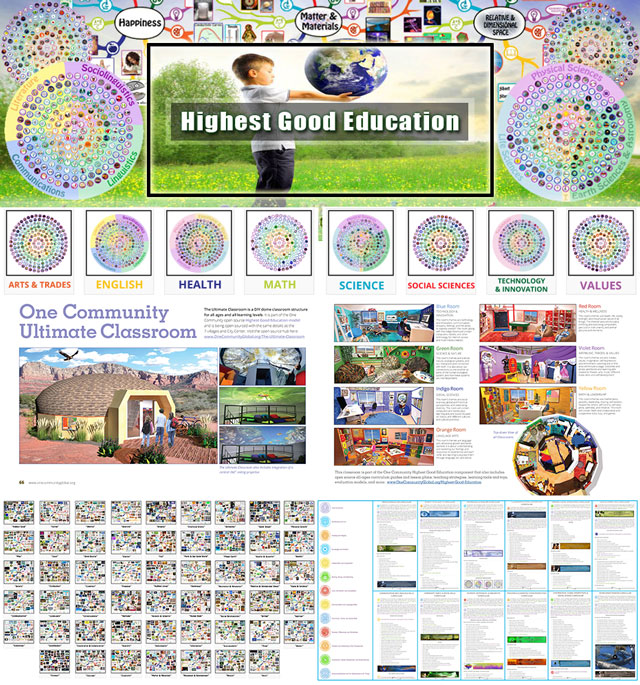
Highest Good Education: All Subjects | All Learning Levels | Any Age – Click image for the open source hub
HIGHEST GOOD SOCIETY PROGRESS
 One Community is forwarding eco-paradigm construction through a Highest Good society approach to living that is founded on fulfilled living, the study of meeting human needs, Community, and making a difference in the world:
One Community is forwarding eco-paradigm construction through a Highest Good society approach to living that is founded on fulfilled living, the study of meeting human needs, Community, and making a difference in the world:
-
-
- Read the Highest Good society eco-paradigm construction overview: Highest Good Society
- Learn about the model for fulfilled living and sharing as part of eco-paradigm construction: A Day in the Life
- Learn about the 4 economic models for eco-paradigm construction: RBE | For-profit | Non-profit | Entrepreneurship
- Learn about our open source community eco-paradigm construction collaboration and management software: The Highest Good Network
-
This week, the core team completed around 65 hours managing One Community volunteer-work review not included above, emails, social media accounts, web development, new bug identification and bug-fix integration for the Highest Good Network software, and interviewing and getting set up new volunteer team members. They also shot and incorporated the video above that talks about forwarding eco-paradigm construction and how eco-paradigm construction is a foundation of the bigger picture of everything One Community is doing. The pictures below show some of this work.
Aaron Wang (Fundraising Assistant) continued helping to research possible funding sources for One Community. This week, Aaron intensified his research on establishing connections with Leonardo DiCaprio, uncovering emails and LinkedIn profiles of individuals likely connected to DiCaprio. This effort aims to streamline the process of engaging with funders by developing relationships with key figures associated with these donations. Establishing win-win relationships like this are a big component to One Community’s vision for forwarding eco-paradigm construction. Images below show their progress for the week.
Arun Chandar Ganesan (Volunteer Data Analyst And SEO And Social Media Assistant) focused on optimizing 10 web pages for SEO and awaited feedback. Simultaneously, he completed social media scheduling for the next month. Following this, he finished the SEO process for the remaining pages and updated the scores in the designated sheet, ensuring progress across multiple digital marketing tasks. Search engine optimization and an ongoing outreach program are important parts of One Community’s model for creating the eco-paradigm construction. These images show his progress for the week.
Cody Media Productions (Video Editing Company) continued working on finalizing the intro video for the weekly progress update YouTube videos. They submitted their third rough cut and gauged the positive feedback received. The team initiated adjustments to the intro video, addressing specific modifications as requested. These videos will showcase the open source components of One Community as the prototype for forwarding eco-paradigm construction. The following images highlight their work.
Faisal Rasheed (Graphic Designer) visited the One Community site map to explore graphics that could potentially be improved upon, including graphics used from other sites. Subsequently, he sent the links for approval and officially began work on the “grown in-ground versus what you can grow in pots” and the “why people do gardening?” infographics. Completing these contributes to One Community‘s vision for forwarding eco-paradigm construction. The images below show his progress for the week.
ADMINISTRATION TEAM
The Administration Team’s summary, covering their work administrating and managing most of One Community’s ongoing process for forwarding eco-paradigm construction was managed by Vriddhi Misra (Admin and Marketing Assistant) and includes Camilla Okello (Administrative Assistant), Charuvi Saxena (HR Specialist), Durgeshwari Naikwade (Data Analyst), Gokul Palanisamy (Data Analyst), Jessica Fairbanks (Administrative Assistant), Jiaxin Zheng (Data Analyst), Meenakshi Velayutham (Sustainability Associate), Olawunmi “Ola” Ijisesan (Administrative and Management Support), Ram Shrivatsav (Data Analyst and Admin assistant), Ratna Meena Shivakumar (Data Analyst and Admin), Ruiqi Liu (Administrative Assistant), Sinddhuzaa Poduri (Data Analyst and Admin assistant), Sneka Vetriappan (Data Analyst), T R Samarth Urs (Data Analyst), Vibhav Chimatapu (Data Analyst/Admin Assistant), Xiaolai Li (Administrative Assistant), and Zuqi Li (Administrative Assistant and Economic Analyst). This week, Camilla managed her administrative duties by completing weekly tasks, reviewing other admins’ work, and optimizing blogs with corrections to keywords. Charuvi contributed to the hiring process by interviewing candidates, recording details, offering suggestions in collaboration documents, and providing feedback on applicant videos. Durgeshwari completed all assigned initial training tasks for the admin team, integrating feedback and ensuring the completion of tasks. Gokul balanced regular tasks with updated SEO feedback, conducted interviews, and delivered detailed feedback. Jessica worked on administrative tasks, refined her skills, and expanded her responsibilities by joining the hiring team. Jiaxin focused on review processes, SEO optimization, and assisting new team members’ training, ensuring SEO scores above 90 for webpages and providing feedback on their work. Meenakshi continued administrative tasks, reviewed and suggested updates for various analyses, and proofread social media web images for accuracy. Ola organized folders, added new team members, tracked progress reports, and reviewed the training work of new volunteers. Ram understood software development processes, managed the PR review team, and provided feedback to new team members. Ratna reviewed progress updates, prepared collages, shadowed interviews, discussed hiring processes, and improved SEO scores for blogs. Ruiqi completed review processes, created collages, incorporated SEO keywords, and supported new admins’ training while engaging in SEO and analytics tasks. Sneka worked on administration and software development tasks, provided feedback, optimized webpages, and contributed to software testing efforts. Samarth managed the PR review team, applied SEO techniques to optimize blog posts, reviewed fellow admins’ work, and received constructive feedback. Vibhav completed training on webpage SEO optimization, enhanced blogs, reviewed the team’s work, and optimized webpages for SEO. Vriddhi managed administrative tasks, reviewed and assigned blogs, provided feedback, and edited and submitted blog posts with a commitment to success. Xiaolai finalized the weekly report, reviewed documents, administered tutorials, assessed training processes, and organized documents for the weekly report. One Community’s model for eco-paradigm construction includes developing and maintaining a huge administration team like this. You can see the work for the team in the image below.
GRAPHIC DESIGN TEAM
The Graphic Design Team’s summary was managed by Ruiqi Liu (Administrative Assistant) and included Ashlesha Navale (Graphic Designer), Britney Robles (Graphic Designer), Nancy Mónchez (Graphic Designer), and Zixi Zhang (Graphic Designer). Ashlesha spearheaded the creation of seven Social Media Images, while also undertaking research and curation of nature-based and theme-specific background images for the task. She fixed and redesigned approximately twelve social media images, ensuring their alignment with desired aesthetics and updating her image repository accordingly. Britney began her first week of volunteering with One Community as a graphic designer. She created five social media graphics, experimenting with diverse styles and imagery to meet role expectations. Nancy addressed design corrections flagged by administrators and investigated incomplete tasks, discovering a technical glitch hindering task verification in Google Docs. Zixi completed the initial app setup and checklist requirements, guaranteeing the app’s readiness for use and adherence to registration protocols. She created two sets of social media images in line with campaign objectives, totaling seven images, and refined three existing social media visuals for enhanced audience engagement, ensuring their availability on Dropbox for seamless access. See the Highest Good Society pages for more on how this relates to forwarding eco-paradigm construction. The collage below shows some of this work.
HIGHEST GOOD NETWORK PROGRESS
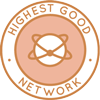 One Community is forwarding eco-paradigm construction through open source Highest Good Network® software that is a web-based application for collaboration, time tracking, and objective data collection. The purpose of the Highest Good Network is to provide software for internal operations and external cooperation. It is being designed for global use in support of the different countries and communities replicating the One Community sustainable village models and related components.
One Community is forwarding eco-paradigm construction through open source Highest Good Network® software that is a web-based application for collaboration, time tracking, and objective data collection. The purpose of the Highest Good Network is to provide software for internal operations and external cooperation. It is being designed for global use in support of the different countries and communities replicating the One Community sustainable village models and related components.
This week, a core team member worked on the Highest Good Network PRs testing, confirming fixed PRs including making WBS names active links (PR#1985), addressing different date formats in time-off requests (PR#1471), fixing Team Management alerts (PR#1185), adding explanatory “i” icons (PR#1000), implementing conditional formatting for multi-word names (PR#1970), updating Teams Page sorting (PR#1756 + PR#1757), fixing Projects and Teams Page formatting (PR#1746), and enhancing project update speed on User Profile and Timelog (PR#596). Unresolved PRs include creating a Blue Square Reason Scheduler (PR#1471) and adding features to various pages. Additionally, they recorded a video regarding the issue of the horizontal scroll bar not appearing when searching for teams not listed at the end, reported a bug concerning the timer stopping on the WBS page, and provided suggestions for formatting headers on Projects and Teams pages along with relevant images. See the collage below for their work.
ALPHA SOFTWARE DEVELOPMENT TEAM
This week, the Alpha Team’s summary, covering their work on the Highest Good Network software was managed by Sucheta Mukherjee (Software Developer) and includes Cooper Bjorkelund (Frontend developer), Navya M (Full Stack Developer), Pratima Singh (Software Developer), and Shamim Rahman (Software Engineer). The Highest Good Network software is how we’ll be managing and objectively measuring our process for forwarding eco-paradigm construction through our social architecture, construction, production, and maintenance processes. This week, Pratima set up the ViewReport page, creating five distinct tabs for improved functionality, including a horizontal bar chart and a donut chart using D3.js to effectively showcase volunteer statistics, enhancing user experience and facilitating informed decision-making for stakeholders (PR: 2070). Navya collaborated with the unit testing team, attending meetings to familiarize themselves with tasks. Additionally, Navya worked on PR #813, reviewing, testing, and approving code changes locally, testing both positive and negative scenarios and different roles to ensure expected behavior, planning further review before raising the PR. Shamim reviewed 9 different pull requests (PRs) and tested their functionality, providing constructive feedback with accompanying screenshots and videos, addressing issues in PR#1831 and PR#704, and sharing them via Dropbox. Cooper advanced in the development of the toggle tangible time permission feature of the HGN app, making significant progress and addressing minor issues collaboratively with the team, maintaining open communication, providing updates on eco-paradigm construction, and actively participating in discussions throughout the week to achieve project milestones. See the Highest Good Society and Highest Good Network pages for more on how this relates to forwarding eco-paradigm construction. View some of the team’s work in the collage below.
BADGES BUGS SOFTWARE DEVELOPMENT TEAM
This week, the Badges Bugs Team’s summary overseeing advancements in the Highest Good Network software, was managed by Shaofeng Li (Software Engineer) and includes Renan Luiz Santiago Martins César (Full-stack developer), Summit Kaushal (Backend Software Developer), Xiao Zhang (Software Engineer), and Xiaohan Meng (Software Engineer). The Highest Good Network software is how we’ll be managing and objectively measuring our process for Eco-paradigm construction through our social architecture, construction, production, and maintenance processes. This week, Shaofeng participated in a team meeting to discuss the week’s plan, collaborated with Xiao on aligning the development version badges table with the production version database, strategized on testing badge components, debugged the codebase, assisted colleagues in resolving technical issues, modified badges in the production database for testing, and debugged the XhoursXweeks function.
Renan sought assistance regarding an error encountered during the implementation of certain features in the checkXHrsForXWeeks function, tested and identified potential issues with this function, and addressed GitHub-related issues focusing on webpack-dev-middleware problems. Summit focused on re-implementing a feature to obtain maximum hours of every week, devised a design, implemented and tested it, debugged the code, discovered and modified the ‘getTangibleHoursReportedThisWeekByUserId’ function, and fine-tuned the logic to obtain maximum value. Xiao did his part for this eco-paradigm construction software as he addressed comments on pull request number 802, resolved specific issues, enhanced project functionality, and met with the manager to outline the next task centered on verifying the operational integrity of all badge features, and decided to develop a series of unit tests to assess each badge function’s performance. Xiaohan submitted a Pull Request to address a bug in the ‘Assign Badge on profile’ feature, engaged with reviewers on Slack and reviewed badge’s PR2085 identifying issues with badge visibility on user profiles after deletion. See the Highest Good Society and Highest Good Network pages for more on how this relates to Eco-paradigm construction. View some of the team’s work in the collage below.
BLUE STEEL SOFTWARE DEVELOPMENT TEAM
The Blue Steel Team’s summary, displaying their work on the Highest Good Network software, was managed by Nathan Hoffman (Software Engineer, Team Manager) and includes Bhuvan Dama (Full stack Developer), Jingyi Jia (Software Engineer), Shiqing Pan (Full-Stack Software Developer), Swathy Jayaseelan (Software Engineer), Tzu Ning “Leo” Chueh (Software Engineer), and Yaohong Xiang (Software Engineer). This week, Nathan focused on optimizing code efficiency by exploring the consolidation of two API calls within editTeamMemberTimeEntry() and refactoring the logic of getTimeEntriesForPeriod() to streamline and simplify its implementation. Shiqing addressed a bug affecting page formatting on the reports page, ensuring that the result table now appears adjacent to the search function on sufficiently wide screens, and conducted peer reviews for pull requests 1966 and 1940.
Bhuvan did his part for this eco-paradigm construction software as he completed coverage analysis of the SaveButton.jsx file, achieving a coverage rate of 75%, and tackled the implementation of several edge cases identified during previous research on the TableFilter.js file. Jingyi started work on the permission management system related to the project management feature, identifying and addressing limitations in the current setup, with plans to implement and test solutions for these issues. Yaohong addressed remaining issues related to setting up a modal, ensuring functionality and maintainability improvements, and submitted a pull request encapsulating these efforts. Swathy focused on improving the user interface by implementing hover effects for checkboxes and radio buttons, addressing a comment on a previous pull request, and resolving a bug within the User Teams Table component’s test file. Tzu Ning fixed a synchronization issue in the WeeklySummariesReport component, enhancing the user experience by providing real-time updates to team code selections. See below to view their work.
CODECRAFTERS SOFTWARE DEVELOPMENT TEAM
The Code Crafters Team’s summary, covering their work on the Highest Good Network software, was managed by Anirudh Ghildiyal (Software Engineer) and includes Anirudh Dutt (Software Developer), Ramya Ramasamy (Software Engineer), Nahiyan Ahmed (Full Stack Software Developer), Shantanu Kumar (Software Developer), Shengjie Mao (Software Engineer), Sophie Lei (Software Engineer), Weiyao Li (Software Engineer) and Tapan Pathak (Software Engineer). The Highest Good Network software is how we’ll be managing and objectively measuring our process for forwarding eco-paradigm construction throughout our social architecture, construction, production, and maintenance processes. This week, Anirudh D joined the unit testing team, collaborating with Diego and others to develop unit tests and reviewing several pull requests while resolving merge conflicts and build failures, including authoring tests for the login controller.
Anirudh G did his part for this eco-paradigm construction software as he focused on debugging test cases for the TeamsTab and UserTeamProject components, managing the weekly standup, and aiming to resolve two failing test cases. Diego, in partnership with Christy G., facilitated peer programming, reviewed and merged PR 817, updated the userProfileController, and submitted PR 822 for further testing, also guiding Anirudh D in unit testing efforts. Meet devoted his efforts to assessing the front end of phase one, ensuring the integrated pull requests delivered the expected results. Nahiyan undertook a dark mode project, integrating a toggle button on the navigation bar and selecting Oxford blue among other colors for the theme. Ramya, hindered by backend server issues, focused on front-end tasks, debugging the Limit-see-all functionality, and reviewing six pull requests related to unit tests. Shantanu addressed merge conflicts in the “Make Submit for Review” button, contending with dependency version discrepancies. Shengjie developed unit tests for the ProjectsTab component, covering basic rendering, functionalities, and edge cases. Tapan did his part for this eco-paradigm construction software as he tackled memory leaks in the user profile page by optimizing Axios calls and state updates, and Weiyao immersed himself in React/Redux studies for user creation functionality. See the Highest Good Society and Highest Good Network pages for more on how this relates to eco-paradigm construction. The collage below shows some of this work.
EXPRESSERS SOFTWARE DEVELOPMENT TEAM
The Expressers Team’s summary, covering their work on the Highest Good Network software, was managed by Demi Zayas (Full Stack Software Engineer) and includes Aishwarya Kalkundrikar (Full Stack Software Developer), Christy Guo (Software Engineer), Ilya Flaks (Software Engineer), Shereen Punnassery (Full Stack Software Engineer), and Mohammad Abbas (Software Engineer). The Highest Good Network software is how we’ll be managing the eco-paradigm construction throughout our social architecture, construction, production, and maintenance processes. Aishwarya investigated and addressed an issue in the UpdateBulk component for reusables, focusing on fetching the reusables list in the UpdateBulkTable file. She identified the root cause as a lack of data loading from the reducer file and continues to work towards resolving this bug.
Christy did her part for this eco-paradigm construction software as she enhanced unit tests for the team controller, reviewing documentation, and progressing the frontend purchase form and backend routing components for the “Purchase Equipment” feature. Demi collaborated with Ilya to ensure efficient execution of the Tools List Default View task, researching and reviewing phase 2 documentation. Ilya’s contributions spanned resolving merge conflicts, improving the backend controller for the “Log Tool request” task, and advancing the “Tools List Default View” feature by implementing Redux reducers and actions. Mohammad worked on PR reviews, unit and feature testing. Shereen focused on unit testing the WeeklySummaryModal component, and addressing issues related to Unhandled Promise Rejection Warning permissions. See the Highest Good Society and Highest Good Network pages for more on how this relates to eco-paradigm construction. The collage below shows some of this work.
GIT-R-DONE SOFTWARE DEVELOPMENT TEAM
The Git-R-Done Team’s summary, covering their work on the Highest Good Network software, was managed by Sai Deepak Dogiparthi (Software Developer) and includes Chris Chen (Software Engineer Intern), and Rhea Wu (Software Engineer). The Highest Good Network software is how we’ll be managing the eco-paradigm construction throughout our social architecture, construction, production, and maintenance processes. Chris created a schema for managing building equipment data in a MongoDB database using Mongoose. He defined the fields to capture essential equipment details and implemented mechanisms for monitoring equipment conditions and usage through logs. Additionally, Chris established efficient routes within an Express application, directing equipment-related requests to a designated controller for streamlined data fetching and manipulation. Rhea focused on advancing the recent pull request associated with assigned tasks. Sai did his part for this eco-paradigm construction software as he continued their collaboration with Chris on the equipment details page, addressing database inconsistencies. See the Highest Good Society and Highest Good Network pages for more on how this relates to eco-paradigm construction. The collage below shows some of this work.
MOONFALL’S SOFTWARE DEVELOPMENT TEAM
Moonfall Team’s summary, covering their work on the Highest Good Network software, was managed by Lu Wang (Software Engineer) and includes Abdelmounaim “Abdel” Lallouache (Software Developer), Cheng-Yun Chuang (Software Engineer), Haoji Bian (Software Engineer), Jiadong Zhang (Software Engineer), Malav Patel (Software developer), Navneeth Krishna (Software Engineer) and Nnamdi Ikenna-Obi (Software Engineer). The Highest Good Network software is how we’ll be managing and objectively measuring our process for eco-paradigm construction throughout our social architecture, construction, production, and maintenance processes. Abdelmounaim addressed issues such as fixing time off email confirmation, resolving user initial setup style issues, handling conflicts and reviewing pull requests related to project improvements. Cheng-Yun focused on implementing a function to delete a member in the task and project if the member has been removed from the user profile. Haoji improved code reliability and efficiency, making updates such as adding a try-catch block to the user profile handler in the frontend to enhance error handling and resolving merge conflicts with the development branch in both frontend and backend branches.
Jiadong did his part for this eco-paradigm construction software as he replaced badges on the dashboard, enhancing backend functionality, and updating frontend components to reflect changes in the badge count. Lu focused on debugging test functions for critical components, including the AddTaskModal, EditTaskModal, and ImportModal files, and also assisted with team management. She created a mock Redux store using configureStore and provided it to the Provider component for testing the EditTaskModal. Malav worked on fixing bugs in DELETE_TIME_ENTRY_OTHERS feature and HGN software development. He made additional changes to restrict the permission of volunteers to delete owners/admins/Managers Time Entry Log in the code and pushed the changes into his own branch. Navneeth performed final reviews on multiple pull requests, addressing errors during backend environment setup, managing team resources, and providing documentation and training to Lu, the new Manager of Team Moonfall. Nnamdi worked on the team code dropdown list to show 15 items under the weekly summaries component. See the Highest Good Society and Highest Good Network pages for more on how this relates to eco-paradigm construction. Look below for a collage of their work.
REACTONAUTS’ SOFTWARE DEVELOPMENT TEAM
Reactonauts’ Team’s summary, covering their work on the Highest Good Network software, was managed by Masasa Thapelo (Software Engineer) and includes Abi Liu (Software Engineer), Changhao Li (Software Engineer), Peterson Rodrigues (Full-Stack MERN Stack Developer), Shengwei Peng (Software Engineer), Shiwani Rajagopalan (Software Engineer), Vikram Badhan (Software Engineer), Yi Feng (Full-Stack Software Engineer) and Yixiao Jiang (Software Engineer). The Highest Good Network software is how we’ll be managing and objectively measuring our process for eco-paradigm construction throughout our social architecture, construction, production, and maintenance processes. Abi reviewed pull requests 813 and 822, while ensuring the robustness of test cases and addressing previously suggested code changes in pull requests 2077 and 2075. Additionally, Abi authored unit and integration tests for the actionItem controller and routes, covering positive, negative and edge cases. Changhao did his part for this eco-paradigm construction software as he revised previous PRs, fixed import issues in unit tests, and attended team meetings, also creating a team pic folder for teammates. Masasa resolved failing tests on his two PRs, ensuring the smooth progress of the projects.
Peterson finalized his biography for the One Community team announcement and selected a bug to fix in the “HGN Phase I Bugs and Needed Functionalities” document. Shengwei worked on stopping blue square additions for new users by implementing a new notification service and identified performance issues with the user profile page. Shiwani’s worked on two tasks: WBSTasks and TaskDifferenceModal. For WBSTasks, Shiwani did her part for this eco-paradigm construction software as she created 7 additional test cases and for TaskDifferenceModal, 8 test cases, ensuring proper functionality of buttons and modals based on user IDs and states. Vikram focused on unit testing for specific files. Yi contributed to the codebase, focusing on a high-priority task and developed crucial APIs while refactoring previous code for maintainability. Yixiao resolved header test files, reviewing passed test cases and implementing changes for unit test files. See the Highest Good Society and Highest Good Network pages for more on how this relates to eco-paradigm construction. Look below for pictures of this work.
SKYE’S SOFTWARE DEVELOPMENT TEAM
Skye’s summary, covering their work on the Highest Good Network software, was managed by Luis Arevalo (Front End Developer) and includes Jiarong Li (Software Engineer), John Mumbi (Software Engineer) and Yao Wang (Software Engineer). The Highest Good Network software is how we’ll be managing and objectively measuring our process for eco-paradigm construction throughout our social architecture, construction, production, and maintenance processes. Jiarong changed the WeeklySummariesReport.jsx from a class component to a function component. Despite initial challenges in executing the combined version, all code refactoring tasks were accomplished and the current file was merged with others from the development branch into the testing branch.
Jiarong did his part for this eco-paradigm construction software as he documented all procedures and pushed them to a branch to this task, ensuring a smooth transition and subsequent testing phase. John focused on enhancing code to improve efficiency. He addressed this task by identifying and resolving bugs, as well as performing refactoring. Luis collaborated with Diego and the unit testing team to complete testing on the backend, focusing on the warningsController. After reviewing documentation on jest and consulting with Abi in another peer programming session, they developed tests for the postWarningById route. Yao finished a new task involving the transmission of emails to owner, admin, and manager regarding specific volunteer information when an account is paused or deactivated. Yao documented this task in the bug document and initiated the replication of outlined steps detailed in a document on utilizing the Gmail API for email transmission. See the Highest Good Society and Highest Good Network pages for more on how this relates to eco-paradigm construction. See the collage below for some of their work.
SOFTWARE PR REVIEW TEAM A-L
The PR Review Team’s summaries for team members names starting with A-L and covering their work on the Highest Good Network software was managed by Olawunmi “Ola” Ijisesan (Administrative and Management Support) and Jiaxin Zheng (Data Analyst). The Highest Good Network software is a foundation of what we’ll be using to measure our results of eco-paradigm construction. This week’s active members of this team were: Aaron Persaud (Software Developer), Anand Seshadri (Software Engineer), Gayathridevi Chithambaram (Full Stack Developer), Harsh Bodgal (Software Engineer), Hetvi Patel (Full Stack Developer), Hiral Soni (Full Stack Developer), Hoang Pham (Software Developer), Imran Issa (Software Developer), Iven Chih Ken Yao (Software Developer), Jaiwin Thumber (Front-End Develolper), KaiKane Lacno (Software Developer and Team Manager), Kurtis Ivey (Software Engineer), Lin Khant Htel (Frontend Software Developer). They reviewed all the Highest Good Network PRs (Pull Requests) shared in this week’s update. Learn more about how the Highest Good Network will measure and assist in eco-paradigm construction in the Highest Good Network open source hub. The collage below shows a compilation of the work from this team.
SOFTWARE PR REVIEW TEAM M-Z
The PR Review Team’s summary covering their work on the Highest Good Network software was managed by Olawunmi Ijisesan (Administrative and Management Support), Samarth Urs (Administrative Assistant and Data Analyst) and Jiaxin Zheng (Data Analyst). The Highest Good Network software is a foundation of what we’ll be using to measure our results of eco-paradigm construction. This week’s active members of this team were: Mengtian Chen (Software Engineer), Mingqian Chen (Software Engineer), Olga Yudkin (Software Engineer), Parth Rasu Jangid (Software Developer), Raj Nada (Software Developer), Sanket Kaware (Full stack developer), Sarthak Jaiswal (Full Stack Developer), Tim Kent (Full Stack Software Engineer) and Zijie “Cyril” Yu (Software Engineer). They reviewed all the Highest Good Network PRs (Pull Requests) shared in this week’s update. Learn more about how the Highest Good Network will measure and assist in Eco-paradigm Construction in the Highest Good Network open source hub. The collage below shows a compilation of the work from this team.
AND WE PRODUCED THIS WEEKLY UPDATES BLOG – CLICK HERE TO SUBSCRIBE
FOLLOW ONE COMMUNITY’S PROGRESS (click icons for our pages)
INVESTOR PAGES
GET INVOLVED
DONATE ● WAYS ANYONE CAN HELP ● MEMBERSHIP
CLICK HERE FOR ALL PAST UPDATES
 One Community
One Community


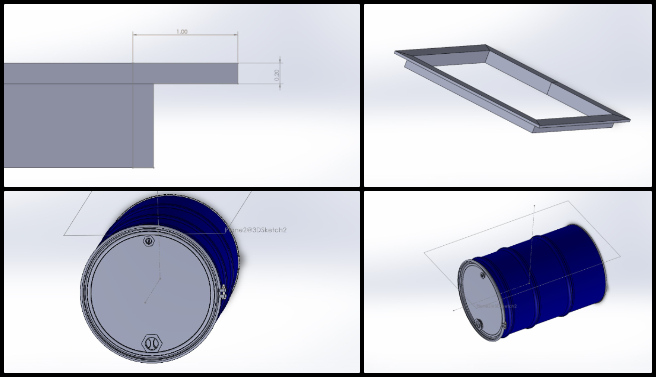
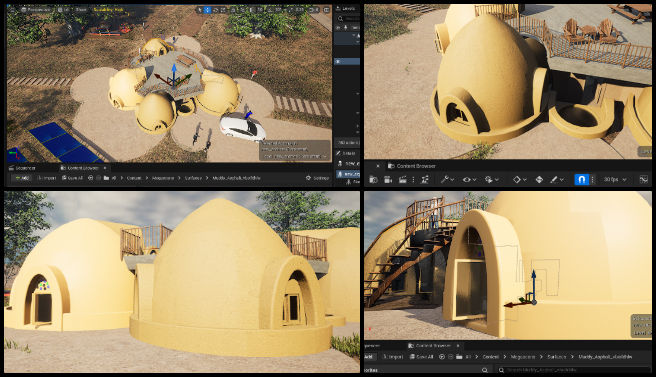
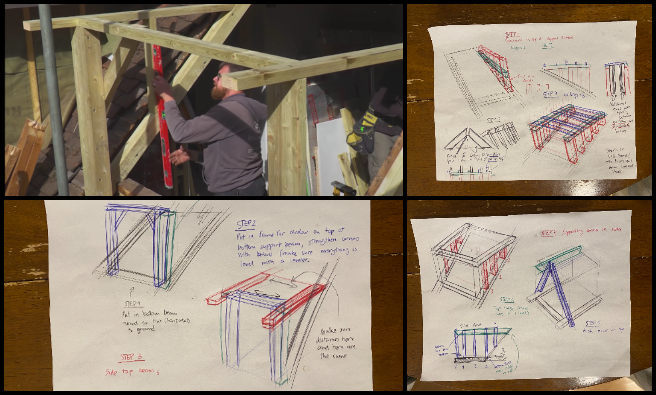
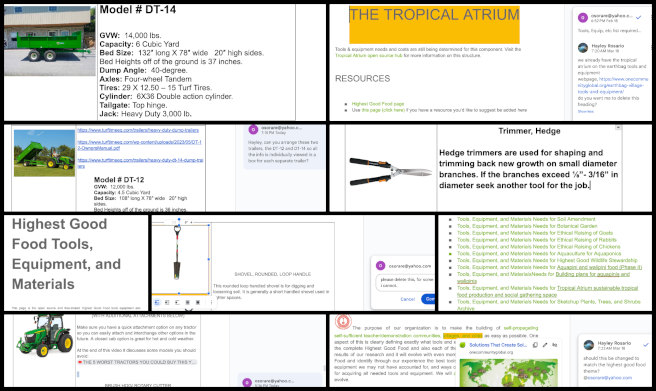
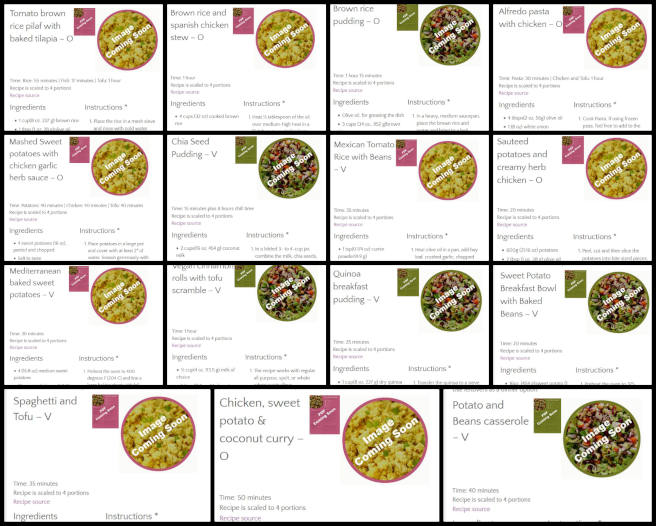
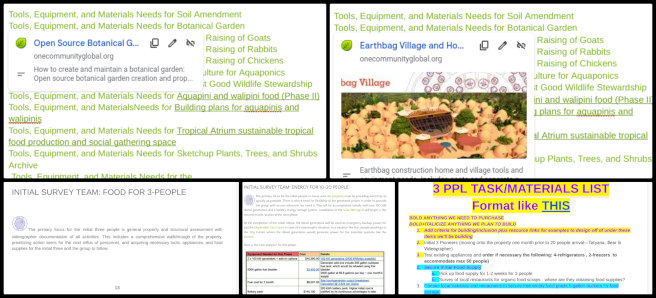
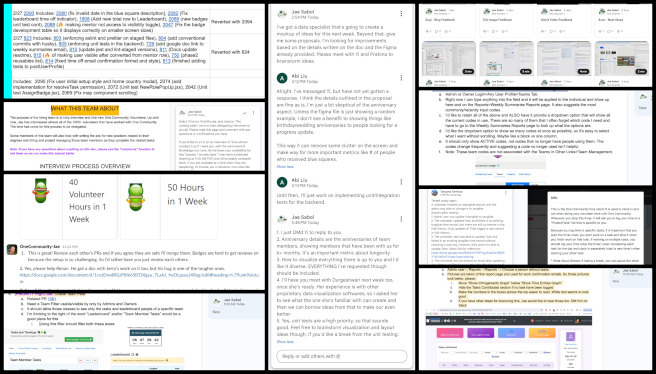
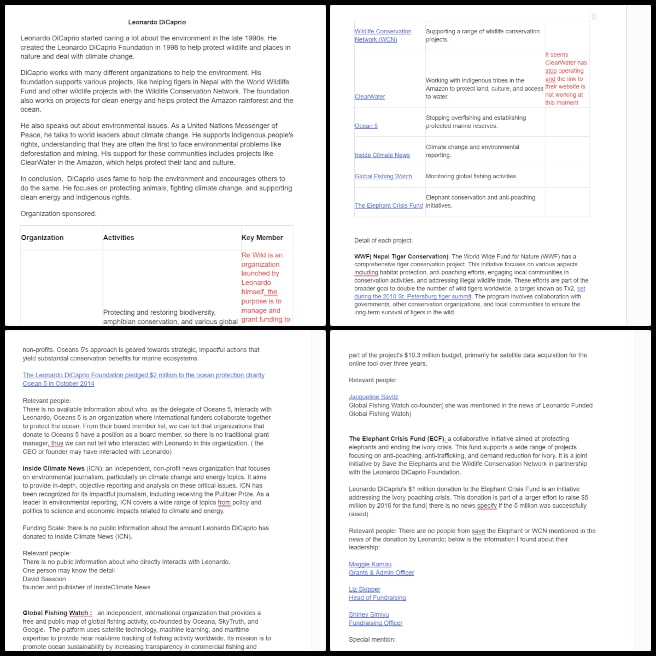
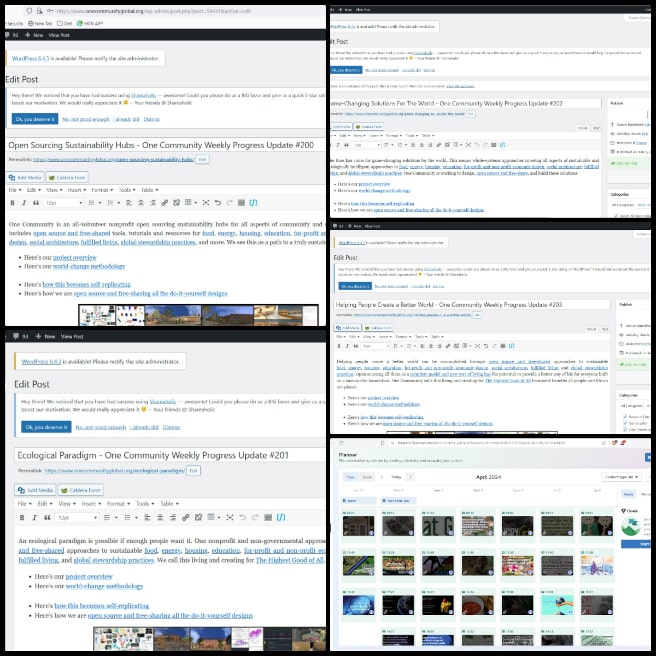
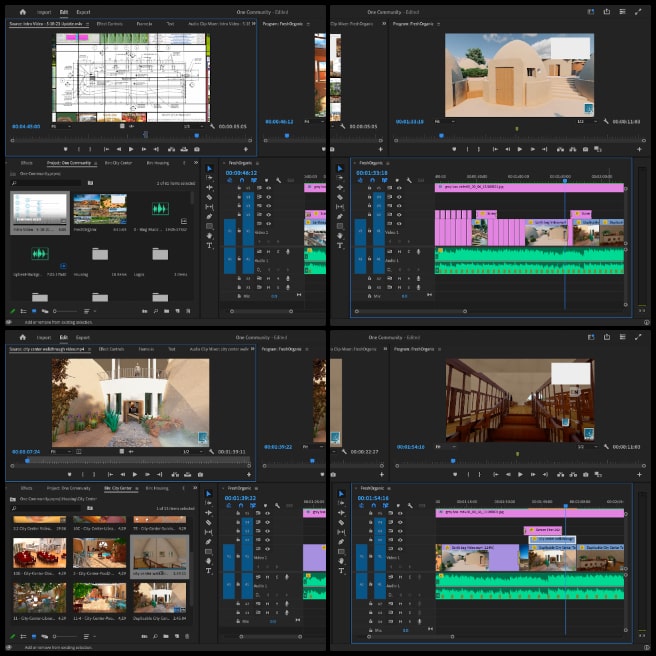
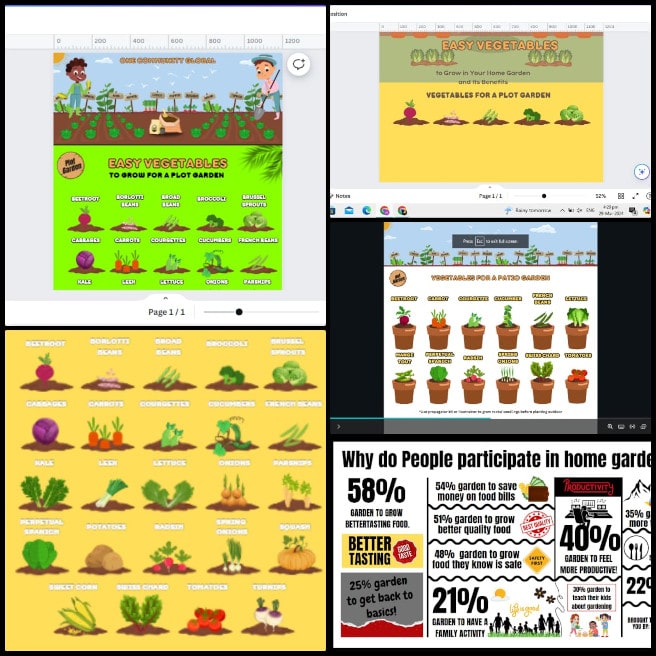
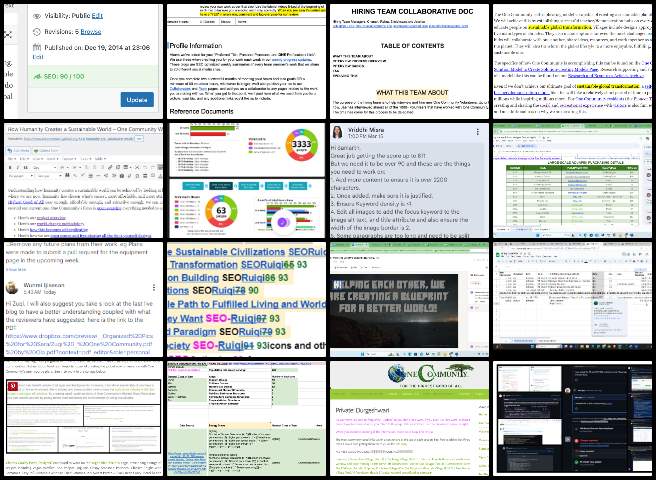
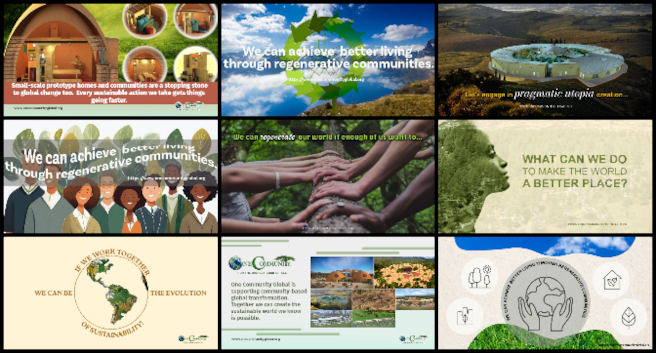
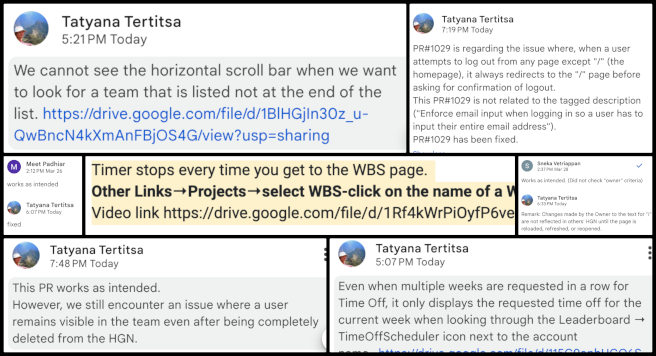
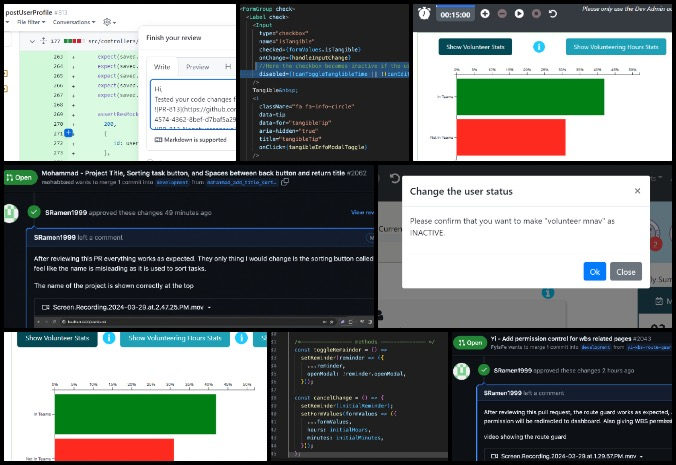
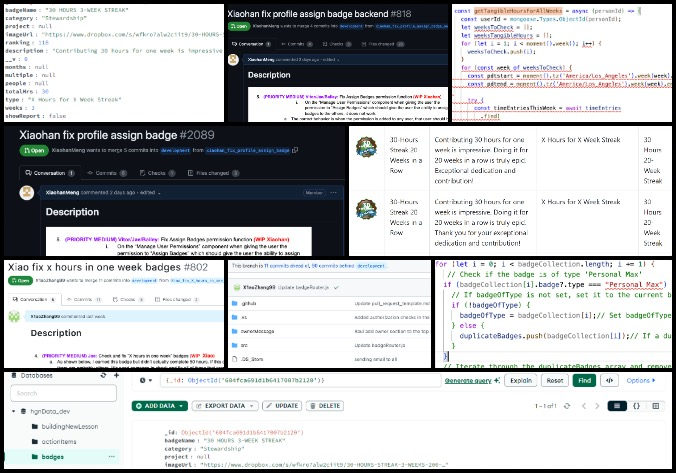
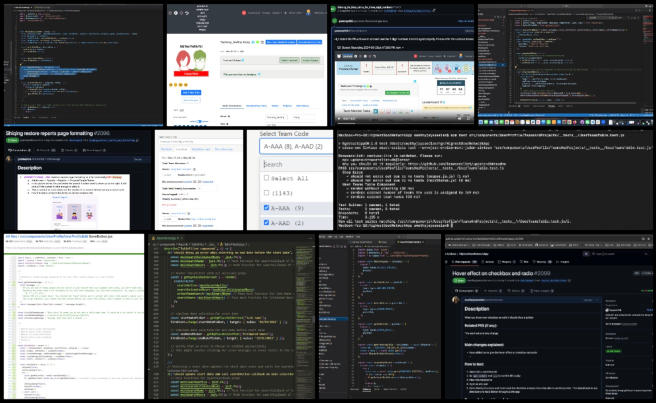
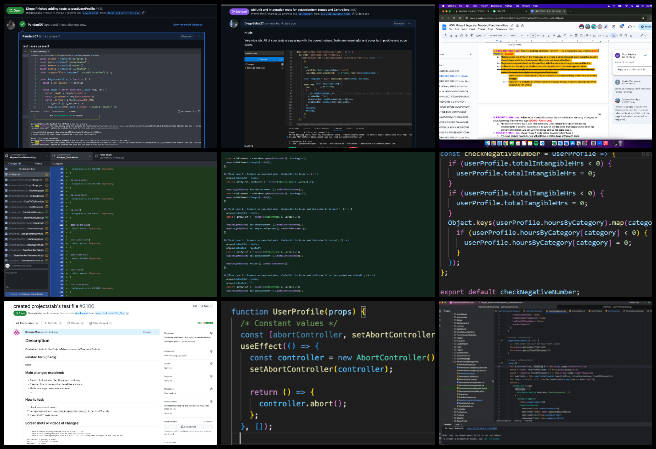
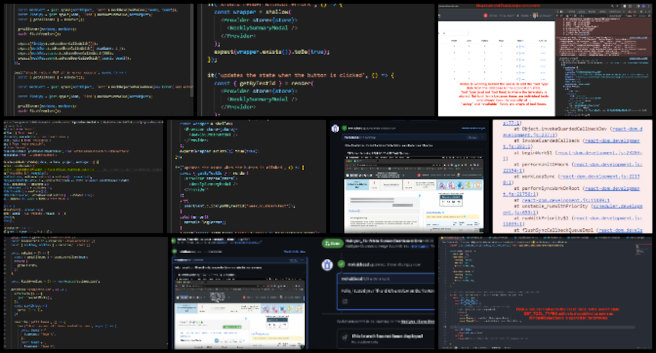
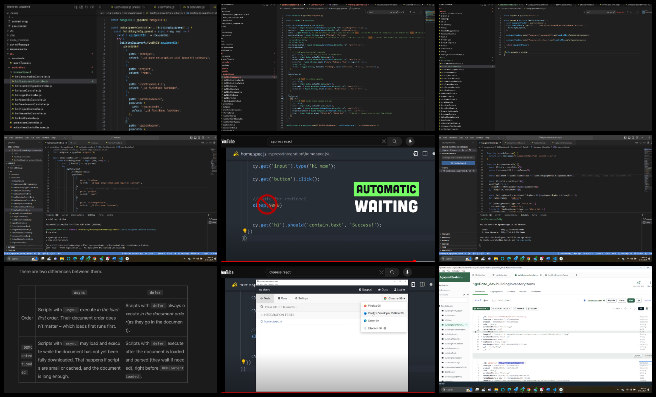
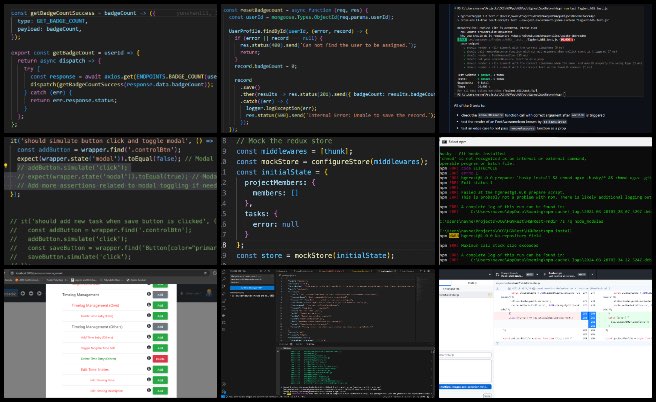
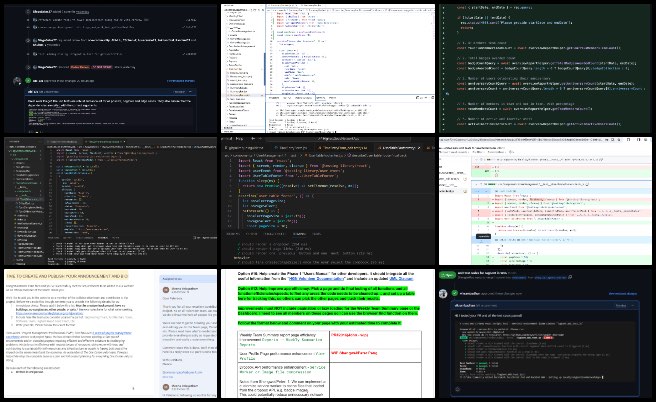
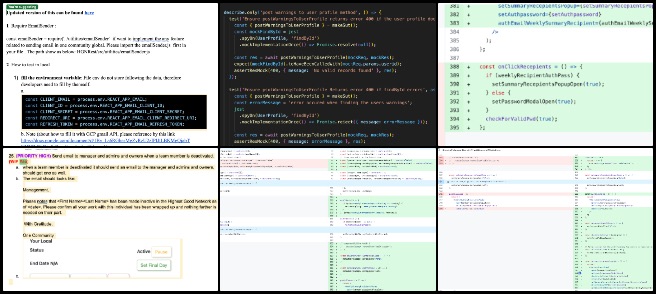
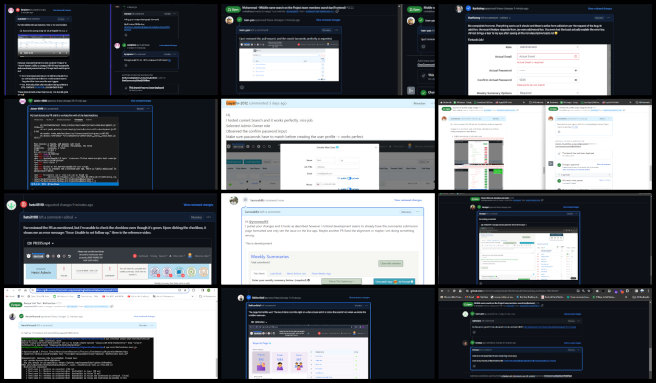




Connect with One Community